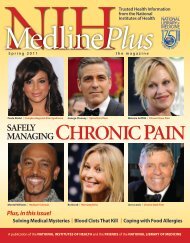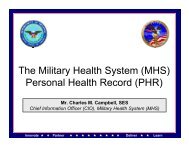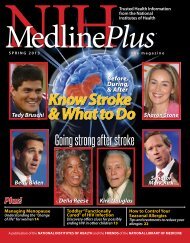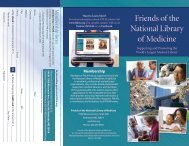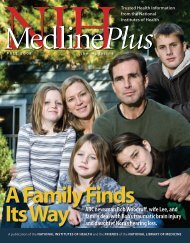Sam Donaldson's cancer survival tips - National Library of Medicine ...
Sam Donaldson's cancer survival tips - National Library of Medicine ...
Sam Donaldson's cancer survival tips - National Library of Medicine ...
Create successful ePaper yourself
Turn your PDF publications into a flip-book with our unique Google optimized e-Paper software.
new understandings developed through the work <strong>of</strong> their<br />
respective institutes.<br />
Currently, addiction affects 23.2 million Americans — <strong>of</strong><br />
whom only about 10 percent are receiving the treatment they<br />
need. “HBO’s project <strong>of</strong>fers us the opportunity to directly<br />
acquaint viewers with available evidence-based medical<br />
and behavioral treatments,” says NIAAA Director<br />
Ting-Kai Li, M.D. “This is especially important for<br />
disorders that for many years were treated outside<br />
the medical mainstream.”<br />
Consisting <strong>of</strong> nine segments, the film<br />
presents an encouraging look at addiction as a<br />
treatable brain disease and the major scientific<br />
advances that have helped us better understand<br />
and treat it. From emergency rooms<br />
to living rooms to research laboratories, the<br />
documentary follows the trail <strong>of</strong> an illness that<br />
affects one in four families in the United States.<br />
One segment, “The Adolescent Addict,” explains<br />
that the adolescent brain differs from the<br />
adult brain because it is not yet fully developed.<br />
According to NIDA’s Dr. Volkow, adolescent brains<br />
may be more susceptible to drug abuse and addiction<br />
than adult brains. However, because it is still developing,<br />
the adolescent brain may also <strong>of</strong>fer an opportunity for<br />
greater resilience. Although treatment can yield positive results,<br />
many families are unwilling to look outside the home for help due<br />
to concerns about stigma.<br />
Medications for use in treating alcoholism also are a focus <strong>of</strong><br />
the program, including a segment on topiramate, under study by<br />
NIH-supported researchers at a clinic in Charlottesville, Virginia.<br />
At present, there are three FDA-approved medications available to<br />
treat alcohol dependence: the older aversive agent disulfiram, and<br />
two newer anti-relapse medications. Naltrexone, available by tablet<br />
or monthly injections, interferes with drinking reward and reinforcement,<br />
and acamprosate works on multiple brain systems to<br />
reduce craving, especially in early sobriety. According to NIAAA’s<br />
Dr. Willenbring, these medications are not addictive and can be<br />
helpful adjuncts to treatment.<br />
“There is a lot <strong>of</strong> exciting new scientific research information<br />
and treatments that we need to get out to the public,” says Dr. Willenbring.<br />
“I think that we are on the cusp <strong>of</strong> a paradigm shift in<br />
the treatment <strong>of</strong> alcohol abuse.”<br />
The Addiction project also includes 13 short feature films from<br />
different directors on innovative family training and treatment<br />
approaches, interviews with leading experts, successful drug court<br />
programs that reduce relapses and re-arrests, and dealing with the<br />
dynamics <strong>of</strong> a disease that sometimes requires as much investment<br />
from family and community as it does from the individual<br />
struggling to recover. A comprehensive four-DVD set <strong>of</strong> the documentary<br />
and the 13 short films is available nationally. n<br />
NOTE: Although the dangers <strong>of</strong> nicotine addiction were not a part <strong>of</strong> this study,<br />
tobacco’s impact on the health <strong>of</strong> Americans will be included in future issues.<br />
Number (in Thousands) <strong>of</strong> Americans Age 12 and Older<br />
Dependent on or Abusing Alcohol and Illicit Drugs<br />
On the Web<br />
Marijuana / 4,090<br />
Pain Relievers / 1,546<br />
Alcohol / 18,658<br />
Source: Substance Abuse and Mental Health Services Administration,<br />
2005 <strong>National</strong> Survey on Drug Use and Health<br />
• www.hbo.com/addiction/<br />
This HBO Addiction interactive companion Web site allows visitors<br />
to customize information for their specific needs, with a special<br />
emphasis on treatment options. The site features original content<br />
by the nation’s leading experts in the science <strong>of</strong> addiction and<br />
addiction treatment, all 14 films in chaptered form, and comprehensive<br />
informational <strong>tips</strong> and resources.<br />
• www.drugabuse.gov<br />
The Web site for the <strong>National</strong> Institute on Drug Abuse (NIDA)<br />
contains information on all facets <strong>of</strong> drug abuse, as a part <strong>of</strong> NIDA’s<br />
mission to lead the nation in bringing the power <strong>of</strong> science to bear<br />
on drug abuse and addiction.<br />
• www.niaaa.nih.gov<br />
The Web site for the <strong>National</strong> Institute on Alcohol Abuse and Alcoholism<br />
contains research, resources, and related materials on the<br />
institute’s work in the fight against alcohol abuse and alcoholism.<br />
Heroin / 227<br />
Hallucinogens / 371<br />
Inhalants / 221<br />
Cocaine / 1,549<br />
Stimulants / 409<br />
Tranquilizers / 419<br />
Sedatives / 97<br />
www.medlineplus.gov Spring 2007 17



